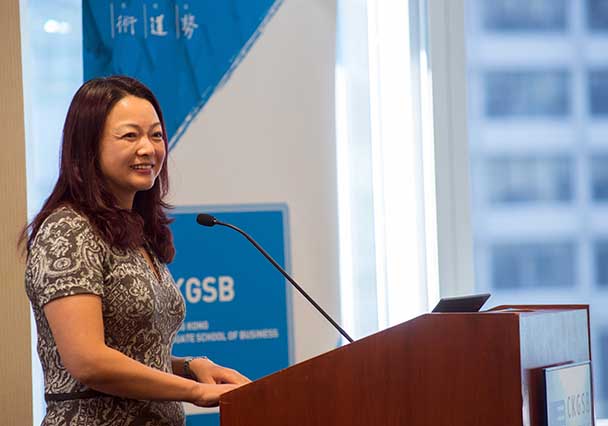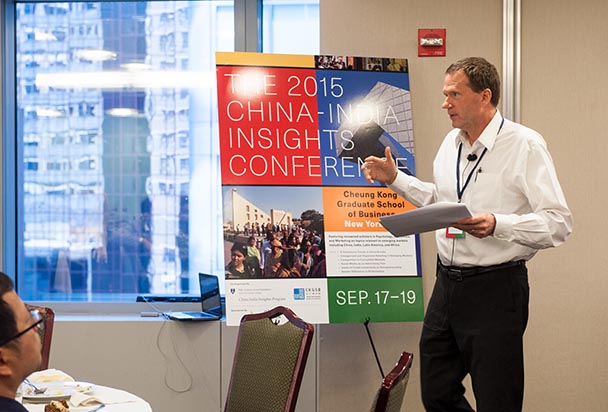The 2015 China India Insights Conference showcased a plethora of ideas from academics and researchers in emerging markets aimed at helping managers globally run and market businesses more efficiently amid a backdrop of rapid technological change.
Scholars from marketing, finance and other fields at the seventh annual conference September 17-19 – a CKGSB Knowledge Series Event in partnership with Yale School of Management – shared data on consumer and firm behavior that managers and marketers could leverage to battle challenges in an ever-competitive marketplace.
The parley at Manhattan’s Citi Executive Conference Center featured 19 presentations September 18 and 11 presentations on September 19. A September 17 panel discussion held at CKGSB’s New York office highlighted the implications for companies, customers and economies of the e-commerce surge in China and India and the nations’ potential as e-commerce marketplaces for Western firms.

CKGSB Professor of Marketing Sun Baohong welcomes attendees
to the 2015 China India Insights Conference in New York City
Prior to the start of the panel discussion, Sun Baohong, the Dean’s Distinguished Chair Professor of Marketing and the Associate Dean of Global Programs and Director of the Customer Information Management Center at CKGSB, said the growing prominence in China of the online-to-offline, or O2O, business model reflects the sophistication of Chinese e-commerce. O2O, which directs online users to physical stores, is seen as increasing opportunities in marketing and customer acquisition, especially in the consumer goods and services verticals. An e-commerce alliance struck in 2014 by technology and Internet innovators Tencent and Baidu and real-estate giant Wanda brought O2O’s viability as a strategy in China into sharp focus.
“The challenge in China is not about buying online,” Professor Sun said. “It is about how to deliver fish and lobsters alive to a kitchen. That’s how advanced e-commerce in China is.”
With O2O a “big buzzword” in China, according to Professor Sun, “traditional companies are thinking about re-branding or trying to build an empire online. … All this is related to the Internet thinking advocated by the Chinese government.”
Some 80 people registered for the conference. The event was sponsored by the Sheth Foundation, which supports the scholarship, publications, education and research of tax-exempt, publicly supported educational organizations. Primarily focusing on the discipline of marketing, it provides support to grant-awarding recipient organizations.
Kicking off the proceedings, K. Sudhir, the James L. Frank Professor of Marketing, Private Enterprise and Management at Yale School of Management and Director of the Yale China India Insights Program, emphasized the conference’s value in giving practitioners a global view of marketing trends via rigorous academic research.
“It’s important to learn (from presented data) why things work and why they don’t,” Professor Sudhir said. “Not only changing across countries, but within countries. Hopefully, it will help us learn about marketing, what I would call the big m of marketing – the cross country variations,” he said.
“We’re very, very good at the small m of marketing in that we try to take data and try to improve efficiency around it in particular settings,” Professor Sudhir said. “In the big m sense, this kind of cross-country variation is going to be very valuable.”

CKGSB Associate Professor of Strategy and Economics Brian Viard
gives a presentation on Day 1 of the 2015 China India Insights Conference
The presentations covered the gamut of topics. One Day 1 session, “Dynamics of the Subnational Regional Effect: Evidence from China,” led by Brian Viard, an Associate Professor of Strategy and Economics at CKGSB, studied the dynamics of subnational regional effects in firm performance for foreign affiliates of multinational companies in China. Its key finding – that it is important for firms to understand local institutions even as an economy develops rapidly – fits with the idea advanced by CKGSB academics that succeeding in doing business with China depends on a good understanding of local needs and wants.
The first day also included titles such as “Do Credit Constraints Limit Entrepreneurship? Heterogeneity in the Returns to Microfinance,” which examined subjects in urban Hyderabad, India, six years after microfinance was randomly introduced to a subset of neighborhoods. Another topic was “The Marketing Lives of Micro-Entrepreneurs: Why Do Some Differentiate Themselves from Their Competitors More than Others?” which examined competitive differentiation among the most common type of marketers in the world: micro-entrepreneurs in emerging markets.
Day 2’s program included presentations on “Competition in Corruptible Markets,” which investigated implications for firms competing for business, and for the buyer in a corruptible market, and “New Product Development Partnerships in Emerging Markets: Drivers of Firm Value,” which analyzed 91 publicly traded North American-headquartered global companies which did partnering new product development in India during 1991-2013.
The presenters’ diverse credentials fit with the conference’s mission: to provide a forum for scholars from across disciplines to share the best available research on consumer and corporate behavior in China and India, two of the world’s fastest growing markets.
Topics reflected how China’s government is encouraging consumption to move the economy away from growth driven by investment and exports. One presentation was titled “Long Term Effects of Prosperity in Youth on Consumption: Evidence from China,” which assessed how experiencing prosperity in youth impacts long-run consumption in non-traditional categories.

Audience members at the 2015 China India Insights Conference
Although e-commerce was a popular topic, some presentations focused away from pure commerce. One, for instance, was titled “Are Gender Differences in Performance Innate or Socially Mediated?” A lab experimental literature explored whether women and men have innate differences in ability as well as preferences and attitudes, and a parallel field-based literature studied discrimination against women in market settings.
While the conference emphasized research related to China and India, presentations that looked beyond the borders of the two countries were also welcome. One was titled, “Mobile Money in Tanzania.” It analyzed a large individual-level data set on mobile money transactions from Tanzania and used a natural experiment of an unanticipated increase in transaction fees.
Generally, transaction data often reflected how the mobile revolution has accelerated e-commerce in China and India. For instance, the session, “Great and Small Walls of China: Distance and Chinese C-Commerce,” examined the role of distance in Chinese e-commerce using data from Alibaba’s Taobao, China’s dominant C2C e-commerce platform.
In the late 1990s, e-commerce was sluggish in China, with the Internet mostly used for gaming and for information. When e-commerce began to take off in 2007, Internet activity still was mostly desktop and PC-based. The past few years have seen the mobile Internet generate a dramatic increase of e-commerce. Mobile also has sped up Internet finance adoption in China.
China is the world’s largest e-commerce economy, with sales valued at $430 billion U.S. India e-commerce, by contrast, is valued at just $15 billion. But its fivefold growth in the past half-decade and the huge amount of money flowing into the sector have raised expectations that it will grow even faster in the years to come.